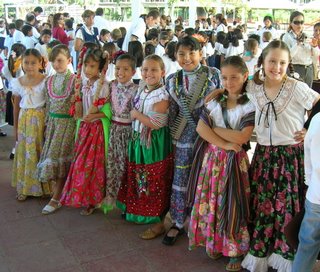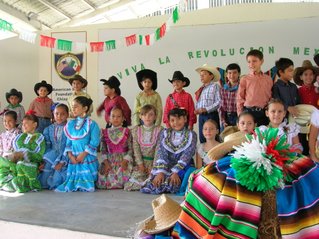
I feel like I laugh more here in Tuxtla than I do at home. It would be hard to measure this, but a lot of funny stuff happens.
The first thing that comes to mind is one of my students, Alejandro. I teach him during the day and after school in an ESL group with four students. At one point he announced, "That is very foony!" (The u takes an oo sound in Spanish, so this would seem a logical pronunciation for the word funny). Besides being a delightful kid, Alejandro is a great sport and I still periodically tease him by suggesting that something is foony. The other kids in the group occasionally describe something as foony as well. He never forgets the correct pronunciation of U now.
Kids funny answers on tests and in their work.Name one animal that lives in the forest - SQUIRTLE (How the kids found out about that mad scientist interbreeding squirrels and turtles is beyond me.)
Name one animal that lives in a desert habitat - JELLYFISH
"When I get home from school, my mother likes to" - SNEEZE
The ClassroomI love to make jokes in the classroom. When giving a spelling test, like most teachers, I say the word, make a sentence and repeat the word. For years I have departed from the format a little. I say the spelling word, make a harmless sounding sentence, pause and add something to the sentence to change the meaning. Then I repeat the word.
A few examples (Keep in mind they are much funnier in the classroom - you have to be there!)
PRAISE - Mr. Glenn likes to praise his students . . . once a year, whether they need it or not. PRAISE
LAMB - Mary had a little lamb . . . and then she had a little potatoes and salad, too. LAMB
Life in GeneralA great thing about speaking a foreign language is that very few people expect you to joke around. If you say something weird, they assume initially that it is because you are a foreigner and foreigners are strange.
Recently I was about to order some food in a restaurant and I noticed that an employee was standing with a few others and he had a tray piled high with coins (that he was intending to count). Because he was standing where you order food with this tray of coins, I went up and stated in my most polite ordering voice, "Me gustaria un orden de monedas, por favor!" (I would like one order of coins, please) Initially all four of their staff stared at me and their expressions were a mix of stunned surprise and 'what do I say, this guy is a complete idiot'. After a very long few seconds, one saw through my mock serious expression and started to chuckle. Then the other three all burst out laughing once they realized I was putting them on. We said nothing more after I ordered my food for real, but now and then one of them would look over and smile.
 Having been told by many of my students that the fair is very exciting, I decided to check it out. I was expecting a fair in Mexico to be very different from a fair in Canada. In this I was disappointed. In fact I spent most of my time at the fair searching desperately for (culturally significant) differences between a fair here and the Saanich fair, for example. I was quite pleased to get a picture of a mini-roller coaster with laundry hanging to dry between the tracks. I am quite certain that I have never seen that in Canada. Another nice discovery was the carousel with a dog whose expression suggests rough treatment in a secret CIA prison. Beyond these two examples, only the food was really different. Although it was consistent in the sense that the food sold at the fair was of the fast-food and deep fried varieties.
Having been told by many of my students that the fair is very exciting, I decided to check it out. I was expecting a fair in Mexico to be very different from a fair in Canada. In this I was disappointed. In fact I spent most of my time at the fair searching desperately for (culturally significant) differences between a fair here and the Saanich fair, for example. I was quite pleased to get a picture of a mini-roller coaster with laundry hanging to dry between the tracks. I am quite certain that I have never seen that in Canada. Another nice discovery was the carousel with a dog whose expression suggests rough treatment in a secret CIA prison. Beyond these two examples, only the food was really different. Although it was consistent in the sense that the food sold at the fair was of the fast-food and deep fried varieties.






























